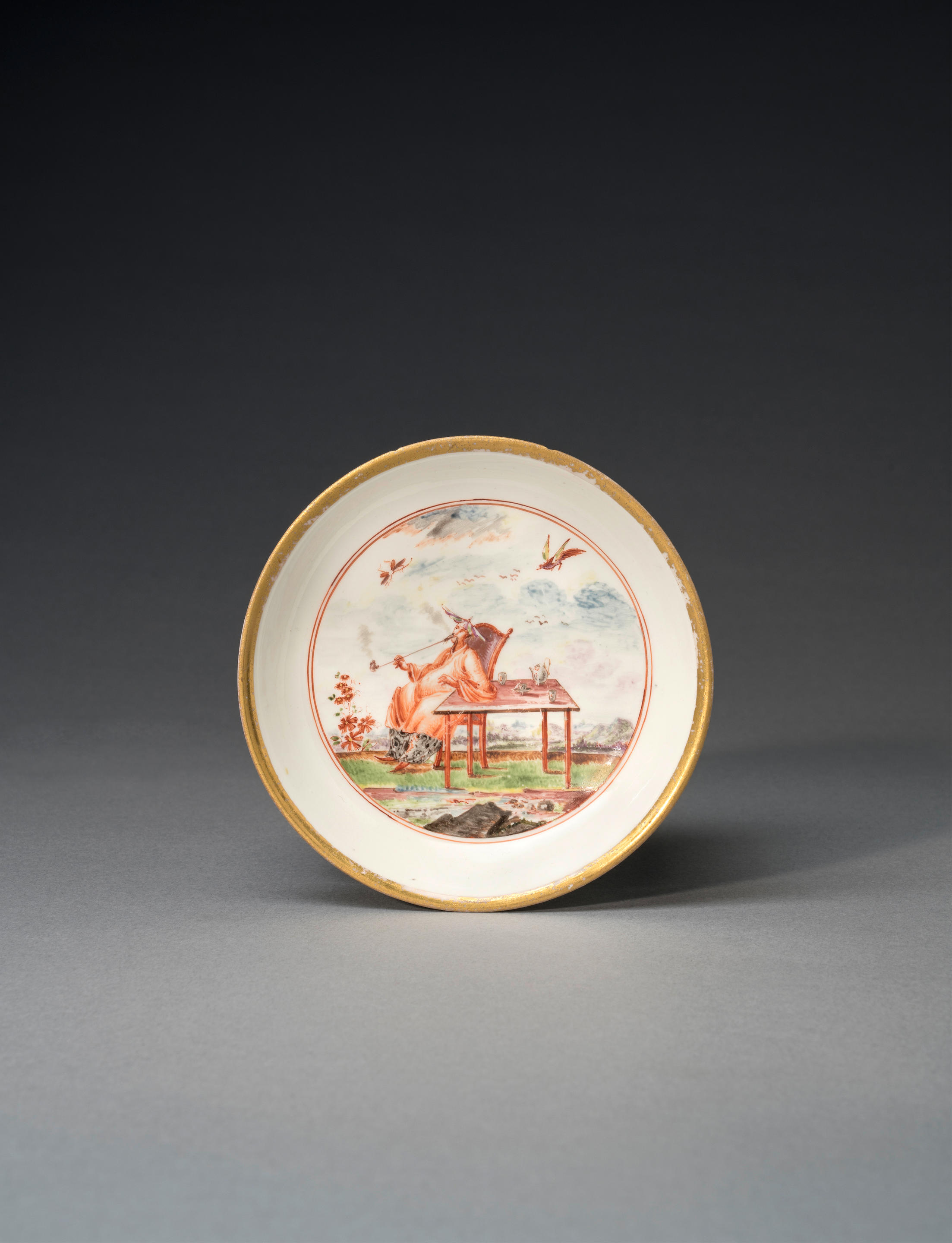An early Meissen gilt porcelain figure of a seated pagod, Circa 1715 modelled seated, wearing loose gilt-patterned robes and a gilt pendant, his right knee drawn up and supporting his right hand, a teabowl and saucer decorated in gilding resting on his fingertips, unmarked.Height: 3¾ in.9.5 cmCondition reportFor further information please contact oppenheimer@sothebys.com; +1 212 894 1442.ProvenanceMargarethe (née Knapp, 1878-1949) and Dr. Franz (1871-1950) Oppenheimer, Berlin & Vienna, bearing label (no. 268 in red);Dr. Fritz Mannheimer (1890-1939), Amsterdam & Paris, inv. no. Por. 166 (acquired between 1936 and 1939);Dienststelle Mühlmann, The Hague (acquired from the Estate of the above in 1941 on behalf of the Sonderauftrag Linz for the proposed Führermuseum);On deposit at Kloster Stift Hohenfurth;On deposit at Salzbergwerk Bad Aussee;Recovered from the above by Allied Monuments Officers and transferred to the Central Collecting Point Munich (MCCP inv. no. 2367/19);Repatriated from the above to Holland between 1945 and 1949;Loaned by the Dutch State to the Rijksmuseum, Amsterdam in 1952 and transferred to the museum in 1960;Restituted by the above to the heirs of Margarethe and Franz Oppenheimer in 2021LiteratureFranz Kieslinger, Verzeichnis der Restbestände der Sammlung Mannheimer, [S.I.], 1941, p. 19, cat. no. 93Joseph De Borchgrave d'Altena, L'influence de l'art chinois sur les arts européens au XVIII siècle, exh. cat., Liège, 1954, no. 46Abraham L. den Blaauwen, Meissen porcelain in the Rijksmuseum, Amsterdam, 2000, p. 421, cat. no. 307ExhibitedLiège, La Salle de l'Emulation, 1954, no. 46Catalogue noteFirst produced in Böttger stoneware from approximately 1711 and in porcelain by about 1713, pagoda figures are recorded in the first inventory of Augustus the Strong's porcelain collection. In the 1721 Inventarium über das Palais zu Alt-Dresden, which lists the contents of the Holländische Palais, later to become the Japanese Palace, 6 examples are recorded under numbers 87 and 88 respectively, published in Böttgersteinzeug Böttgerporzellan, 1969, p. 46. Several dozen pagodas are listed in the warehouse inventories of Dresden and Leipzig in 1719, see Pietsch and Banz, 2010, pp. 170-71, cat. no. 13, where two similar figures modelled with teawares, from the Porzellansammlung, Dresden are illustrated. By 1927, the Oppenheimers owned 32 pagoda figures of various models (Schnorr von Carolsfeld, 1927, nos. 1-29, 32-34,) and continued to acquire examples after their catalogue was published. They were subsequently acquired by Fritz Mannheimer and later sold, Fred. Muller, Amsterdam, October 14-21, 1952, lots 365-389.
An early Meissen gilt porcelain figure of a seated pagod, Circa 1715 modelled seated, wearing loose gilt-patterned robes and a gilt pendant, his right knee drawn up and supporting his right hand, a teabowl and saucer decorated in gilding resting on his fingertips, unmarked.Height: 3¾ in.9.5 cmCondition reportFor further information please contact oppenheimer@sothebys.com; +1 212 894 1442.ProvenanceMargarethe (née Knapp, 1878-1949) and Dr. Franz (1871-1950) Oppenheimer, Berlin & Vienna, bearing label (no. 268 in red);Dr. Fritz Mannheimer (1890-1939), Amsterdam & Paris, inv. no. Por. 166 (acquired between 1936 and 1939);Dienststelle Mühlmann, The Hague (acquired from the Estate of the above in 1941 on behalf of the Sonderauftrag Linz for the proposed Führermuseum);On deposit at Kloster Stift Hohenfurth;On deposit at Salzbergwerk Bad Aussee;Recovered from the above by Allied Monuments Officers and transferred to the Central Collecting Point Munich (MCCP inv. no. 2367/19);Repatriated from the above to Holland between 1945 and 1949;Loaned by the Dutch State to the Rijksmuseum, Amsterdam in 1952 and transferred to the museum in 1960;Restituted by the above to the heirs of Margarethe and Franz Oppenheimer in 2021LiteratureFranz Kieslinger, Verzeichnis der Restbestände der Sammlung Mannheimer, [S.I.], 1941, p. 19, cat. no. 93Joseph De Borchgrave d'Altena, L'influence de l'art chinois sur les arts européens au XVIII siècle, exh. cat., Liège, 1954, no. 46Abraham L. den Blaauwen, Meissen porcelain in the Rijksmuseum, Amsterdam, 2000, p. 421, cat. no. 307ExhibitedLiège, La Salle de l'Emulation, 1954, no. 46Catalogue noteFirst produced in Böttger stoneware from approximately 1711 and in porcelain by about 1713, pagoda figures are recorded in the first inventory of Augustus the Strong's porcelain collection. In the 1721 Inventarium über das Palais zu Alt-Dresden, which lists the contents of the Holländische Palais, later to become the Japanese Palace, 6 examples are recorded under numbers 87 and 88 respectively, published in Böttgersteinzeug Böttgerporzellan, 1969, p. 46. Several dozen pagodas are listed in the warehouse inventories of Dresden and Leipzig in 1719, see Pietsch and Banz, 2010, pp. 170-71, cat. no. 13, where two similar figures modelled with teawares, from the Porzellansammlung, Dresden are illustrated. By 1927, the Oppenheimers owned 32 pagoda figures of various models (Schnorr von Carolsfeld, 1927, nos. 1-29, 32-34,) and continued to acquire examples after their catalogue was published. They were subsequently acquired by Fritz Mannheimer and later sold, Fred. Muller, Amsterdam, October 14-21, 1952, lots 365-389.











Testen Sie LotSearch und seine Premium-Features 7 Tage - ohne Kosten!
Lassen Sie sich automatisch über neue Objekte in kommenden Auktionen benachrichtigen.
Suchauftrag anlegen